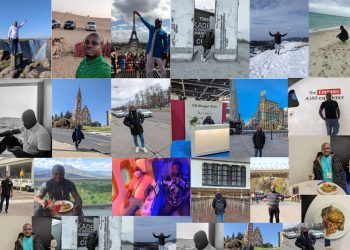Ghana is a country blessed with so many incredible places and things to see, that it is almost a ‘crime’ to stay in Ghana or even visit the country and not take some time off to tour some of these incredibly amazing places, from a town built on water to a town which has a lake full of crocodiles that play with humans. There are just too many wonderful places in Ghana worth visiting.
Jetsanza.com presents the top ten must-see places in Ghana.
NZULEZU
The small town falls within this bracket of strange yet wonderful apparitions. Located some 90 kilometres west of Takoradi, Nzulezu is a strange town that cannot be called an Island; neither can it be referred to as a community on land. The problem with attaching a specific descriptive term to Nzulezu comes about as a result of the nature of the town. Nzulezu is found right on a water body, the Lake Tadane rather than on land. While Nzulezu is not the first town to be built on a lake, it is among the prestigious few in the world and attracts thousands of tourists every year. In the year 2000, it was nominated as a UNESCO Heritage Site and has grown over the decades in terms of popularity and becoming a major tourism destination in Ghana and Africa as a whole.
Houses on the Lake are constructed with wooden materials and stilt supported structures that easily integrate with the water to help the wooden houses stand firm. It remains a mystery as to why the people of Nzulezu chose to leave land and settle on the lake, however history shows that the town has been in existence for over hundred years and still continues to flourish and attract curious tourists from all walks of life. With a small population of just six hundred people, Nzulezu remains one of the most famous towns in Ghana and in most visited community in Africa. For the curious mind, Nzulezu is a town that must be visited at a point in this lifetime.
Paga: Home of the Crocodile Pond
All over the world, crocodiles are not to be one of the most vicious reptiles on the planet, blessed with the ability to fight and defeat almost any creature that comes its way. Its gracious jaws strikes fear into any creature that comes across it, including humans. To sum, it up, crocodiles are not the friendly type of creatures and will strike any living thing in its path with those powerful and fearsome jaws.
But in a small town in Ghana, known as Paga, located in the Upper East region of Ghana, a strange phenomenon exists where these powerful and vicious creatures have struck a love affair with humans beyond the understanding of nature. The crocodiles found in the famous Paga Pond popularly known as Paga Crocodile Pond spend their days on the bank of the pond taking selfies with tourists and playing around. Some adventurous tourists even go to the extent of sitting on the bank of the crocodiles to take pictures. All that has to be done to get the crocodiles to come out of the pond is for the tourist guide to whistle loudly. Once that is done you can expect the crocodiles to heed to the call and crawl towards the bank of the pond.
There they take pictures and play around with the tourist who usually have to buy a chicken for the crocodile before the creatures come close to them. Over the years, Paga Crocodile Pond has attracted millions of tourists from all walks of life. And there has never been an incident of a crocodile attack. The local folks have different stories about how these crocodiles landed in their small town, but generally, there is a belief among the town folks that the spirit of their ancestors reside in these creatures, who have strike an unprecedented love affair with the town folks and humans in general. So if you are curious enough, when planning on your next tourism adventure, Paga Crocodile is one place you wouldn’t want to leave out. The Paga town is located some 44 kilometres outside the regional capital, Bolgatanga.
Mole National Park
Located at Damongo, 146km south-east of Tamale, in the Northern Region of Ghana, Mole National Park is a 12-hour journey by road from Accra.vOne of the largest cities in the Savanna Region, Tamale has a couple of tourist attractions but the Mole National Park stand tall among the rest. With the largest wildlife refuge, Mole National Park has been an attractive site for many in the country due to its unique species. The current location of the Mole National Park was initially occupied by inhabitants of the Northern Region however they were relocated to pave way for the area to be used as a reserve. The famous animals that can be found at the Mole National Park are the African bush elephants and antelopes.
A study conducted on the Park indicates over 800 elephants can be found at the Mole National Park. In terms of tree species Burkea Africana, Isoberlinia Doka, and Terminalia macroptera are some of the species found in the forest. While elephants and antelopes dominate the wildlife in the forest, animals such as buffalos, antelopes and hippos can also be found in the forest even though very small in terms of population. Monkeys have also made the Park their place of abode with the Olive baboons, black-and-white colobus monkeys, the green vervet, and patas monkeys all residing at the park.
Animals such as lions and hyenas used to be found in the park, however, these animals have gone distinct in the park over the last decade raising concerns about the survival of the forest in the coming years. Being one of the last remaining wildlife forests in Ghana, the mole park attracts tourists from all walks of life, both from Ghana and outside every year with an annual visitor population running into almost a million people. For animal lovers, the Mole National Park is a must-visit tourism site to experience the beauty of nature.
Cape Coast Castle
History of the Cape Coast Castle dates back to the 16th century when the Portuguese traders arrived on the shores of Ghana and established a trading post on the shores of the Cape Coast see in 1555. The purpose of the trading post was primarily to serve as a place of shelter and storage of goods such as gold and timber which the Portuguese traders exchanged with the indigenes in a batter trading system. Little did anyone know the trading post would decades later become an infamous castle where indigenes were held captive and then shipped across the Atlantic to the Americas and Europe after being acquired from local slave merchants in the hinterland.
The shift from goods trading to human trading took off in roughly 1654 after the Swedes through a company known as the Swedish African Company had taken over the trading post and further developed it into a well-constructed timber fort with the intent of continuing the trading activities the Portuguese were into. This however changed with the high demand for human labour in the Americas and parts of Europe, convincing the Swedish traders to abandon the commodity trading business and indulge in transporting slaves across the Atlantic to Europe and the Americas.
With the trade in human trafficking booming and generating great and immeasurable wealth for the European traders, the Cape Coast shore soon became a battleground among the Europeans with each seeking to have control over the area and fort as the Cape Coast seashore was a major exit and entry point for the European traders. The fort later fell into the control of the Dutch who also continued the trans-Atlantic slave trade for some time and further developed the fort to make it more resilient to attacks and large enough to keep the slaves captive until they were shipped.
The British were the last group of people to have had control of the fort before worldwide outcry and activism brought the horrendous practice of trans-Atlantic slave trade to an end. The British however did not leave after the practice ended, staying behind to colonize Ghana, making the British government the official owners of the Fort until 1957 when Ghana gained independence and the British government left the shores of the country, handing over the castle to Ghana in the process.
Inside the castle are evidences of the heinous crimes committed against the indigenous people, with objects like shackles used to chain slaves kept in the dungeons on display in the castle. Other notable things one should expect to see upon visiting the castle are the Door of No Return, sediments of decayed bones and flesh of slaves who died before shipment but their bodies were left to rot away by their slave masters. The Cape Coast Castle is definitely a place every Ghanaian must visit at a point in their life, to learn about the suffering and tragedy our forefathers faced.
Mount Afadja
Mount Afadja is located in the small village of Liati Wote in the Hohoe district of the Volta region. Arguably the most talked-about mountain in Ghana, Mount Afadja is the tallest mountain and highest point in Ghana measuring approximately 2,904 ft above sea level. At the top of the mountain, one can see some parts of neighbouring Togo as the mountain is close to the Ghana-Togo border. While it is officially known as Mount Afadja, the Ewe people who dominate the region largely refer to it as Afadjato with the suffix ‘to’ meaning ‘mountain’ hence Afadjato simply means Afadja Mountain.
According to the oral history of the Liati Wote people who live just some few kilometres beneath the mountain, the name came about when they first settled in the area and realized that the mountain was shaped like a mound for planting water yam. The people then resorted to calling the mountain Avadze, an ewe name for water yam. With time as the mountain gained fame and word about it travelled the name metamorphosed into Avadza-to. Statistically, Mount Afadja is one of the most visited tourist sites in the country and receives an average of more than a million tourists annually, with some of the tourists coming from as far as Europe and the Americas. It has become a favourite for hikers and is seen as some sort of sport where getting to the summit of the mountain is seen as the ultimate prize for visiting tourists and hikers.
Atwea Mountains
Atwea Mountain, located in Atwea in the Sekyere Central District of the Ashanti region is undoubtedly one of the most famous mountains in Ghana, probably second only to the renowned Mount Afadja in the volta region. But what makes Atwea Mountain so famous? Unlike most mountainous landscapes which are famous for their attraction of tourists, the Atwea mountain is a unique mountain, famous for its attraction of Christian pilgrims, who visit the township of Atwea occasionally in a bid to climb to the summit of the mountain where they hold prayers and conventions.
This tradition according to the history books begun so many decades ago when one local Methodist pastor in Atwea called Abraham Osei-Assibey ascended the Atwea Bour (Atwea Stone) to go and pray to the Lord. After spending a few days upon the mountain praying to the Lord, he returned to the town and regularly took his fellowship to the mountain top to go and pray with him. This event changed Atwea forever and marked the beginning of the rewriting of the history of the Atwea Township.
The mountain since then has become the most important converging place for Christians all over Ghana; a place where church members go to occasionally especially during Easter periods to have held special prayer events or conventions. Even though the mountain is very steep and tall, this has not prevented Christian groups from visiting the town of Atwea and climbing the mountain to spend a few days praying and hold special meetings.
It is estimated that it takes an average of one hour to climb and get to the summit of the mountain where tents, are erected for visiting groups. While the Atwea Mountain is known for its Christian pilgrimage and religious activities, tourists are not barred from visiting and climbing the famous mountain. In fact Christians who annually make the trip to the mountain, do not only go there with intent to fast and pray but also to satisfy their curiosity and witness for themselves all that they have heard about Atwea mountain, bringing religion and tourism into unison.
Akosombo
For most people living in Ghana, Akosombo is a must-visit town at least once in this lifetime.
Adomi Bridge – The Adomi Bridge is one of the oldest yet most magnificent bridges in Ghana connecting the Eastern region to the Volta region of Ghana. While it is primarily a road facility, it has become one of the most visited places by tourist and is now regarded as a major tourism destination.
Aylos Bay – One of the most popular activities and things to do at Akosombo is to go fishing in one of the many rivers in the town. Among the most popular fishing point in the town is the Aylos Bay where visiting tourists can throw in a hook and line and see the fish they can capture. Tip; fishing at Aylos Bay is best done between the hours of 8am and 4pm as mosquitoes tend to flood the bay from 4 pm and the rest of the evening, making fishing after 4pm very uncomfortable and a health risk.
Royal Senchi Hotel – Akosombo is a town of luxury and there is no better place to experience this luxury than the famous Royal Senchi Hotel. The hotel located in the bend of the river and provides tourists with world-class luxury leaving tourists wishing to revisit for more. The restaurant has a lounge bar, a spa, weekend buffet, and a host of services which ensures visitors have the best time of their lives.
Saachjuna Beach – Perhaps the most popular place in Akosombo, the Sajuna beach is a man-made beach that hosts a number of activities and receives millions of visitors throughout the year. Some of the most popular activities at the beach include beach volleyball, beach soccer, water splash and so on. And what makes the beach the ultimate destination is not just about the sports, but also the food. Sumptuous kebabs, pork, and various local dishes are sold at the beat to add extra spice to the whole beach show.
Kwame Nkrumah Mausoleum and Memorial Park
The Kwame Nkrumah Mausoleum and National Park was built on the old polo ground and dedicated to the first president of Ghana, Dr. Kwame Nkrumah in 1992 under the presidency of Flt. Leut. Jerry John Rawlings. The aim of the mausoleum is to preserve the legacy and historical artefacts of the man who won independence for Ghana and regarded by many as the founder of the nation. The Mausoleum is located directly opposite the old Parliament House of Ghana, which now serves as the office of the Commission on Human Rights and Administrative Justice (CHRAJ).
With a total land surface of 5.3 acres, the Kwame Nkrumah Mausoleum is the largest Historical Museum in Ghana. Just in front of the Mausoleum is the huge statue of Kwame Nkrumah, which can be seen from afar. While only the statue of Kwame Nkrumah can be seen from afar, the interior of the mausoleum has several sections including the graveside and tomb of the late president as well as museum that contains all his memoirs, from signed documents to photographs he took with some of the world’s most powerful and celebrated men of the 20th Century. Some of the famous photographs found in the museum include Dr.
Nkrumah’s pictures with Queen Elizabeth of England, Pope Pius XII, Fidel Castro, President Nasser of Egypt and John F. Kennedy of U.S.A.
The Ancient Town of Elmina
Elmina, known by indigenes as Edina and found in the Central region of Ghana, near Cape Coast is one of the most ancient towns in Ghana and among the first to be discovered by European sailors who arrived on the coast of Ghana in the early 16th century. The Castilians and the Portuguese got involved in a brutal naval war near the village for the control of the guinea trade route which was responsible for the supply of gold and slaves from the inner cities to the coast.
Eventually, the Portuguese proved too strong for the Castilians who were defeated. After defeating Castilla, the Catholic Monarchs of Portugal recognized the area around Elmina as an official territory of Portugal in 1479. Gradually the small tinny village grew, with the local people engaging in trade with the Portuguese. As the town continued to grow and volume of trade between the two parties increased, the Portuguese decided to stamp their authority on Elmina by constructing a Fort on the Coast to ward off other European nations arriving on the coast.
What followed was the construction of the famous Portuguese castle Sao Jorge De Mina on the coast of Elmina by their commander Diogo De Azambuja in 1482. The Fort became the most important trading post in the entire Gold Coast, housing thousands of slaves, gold and other commodities meant for export to Lisbon. In the centuries that followed, Elmina came under Dutch rule and later British rule before the era of total colonization began. Today Elmina is one of the few towns in Ghana that still has remnants of the dreaded slave trade and colonization. On the shore of the sea close to the town, one could see the storied Elmina Castle built by the Portuguese in their quest to control the area and keep slaves captive. While modernization has caught up with us, and most cities and towns in Ghana including Elmina, the town still keeps it ancient outlook with most of the houses in the town being constructed over hundreds of years ago.
Something the people take pride in and say it reminds them of their ancient past. Elmina is also one of the busiest fishing towns in Ghana, with a majority of the working population engaging in the trade either as fishermen or fishmongers and distributers. Politically the town is the administrative capital of the Komenda Edina Eguafo Abriem Municipal District and is headed by a District Chief Executive (DCE). A traditional chief is however responsible for the enforcement and maintenance of customary laws and traditions. Elmina remains one of the most visited communities in Ghana by tourists, especially those coming from places like Europe and America and wish to see the last remains of Ghana’s slavery and colonial past.
Aburi Botanical Garden: the Pride of the East
The Eastern region of Ghana does not boast of much in terms of tourism and side attractions as compared to other regions like the Central region of Ghana. And in fact, the region is one of the less-visited regions for tourists who want to experience nature and some amazing monuments.
One place in the Eastern region which has however held the fort for the region in terms of tourism is the Aburi Botanical garden located on the Akuapem Ridge. The Aburi Botanical garden which occupies an area of 64.8 hectares was first opened in March 1890 was founded Governor William Brandford-Grifith and one John Farrel, a Sierra Leonean Medical doctor. In the 1900s the garden played a very important role in the production of Cocoa as the garden specialized in the growing of cocoa seedlings and also served as a centre where research on Cocoa took seedlings took place.
Over the last hundred years, the garden has undergone changes and modulation to become one of the most visited tourist destinations in the Eastern Region. The Garden which boasts of several plant and tree species such as the Kigelia and spine palm receives lot of visitors during festive periods such as picnics, while a lot of videos in the arts and entertainment industries are shot there due to the beauty and natural scenery of the garden. So if you are in the Eastern region and looking for a tourism site to begin your travel adventure, then the best place to start this journey is the Aburi Botanical Garden located in Aburi on the Akuapem Ridge. For lovers of trees, and natural sceneries, Aburi Garden provides the best experience to have a closer look and feel of such environment.
Still have some travel questions? Ask in our Travel WhatsApp Group.







